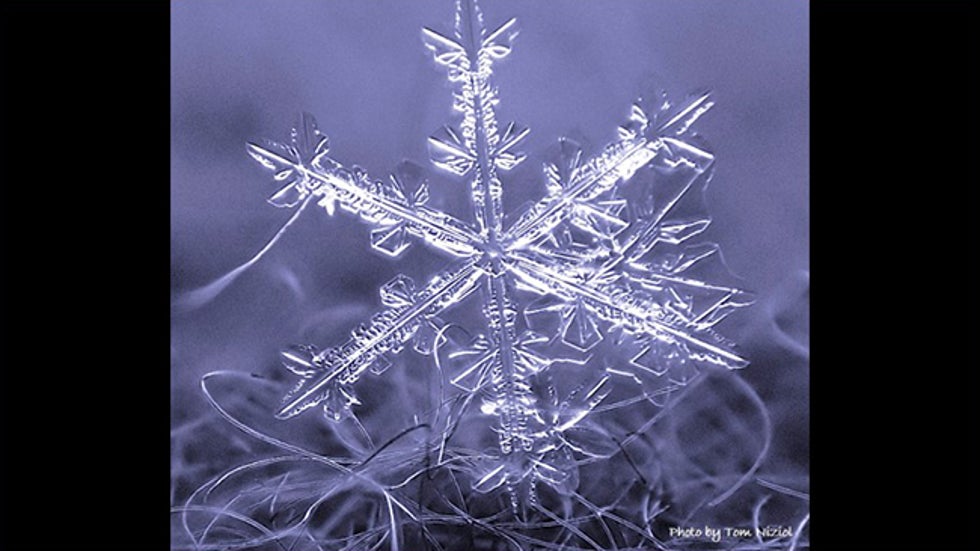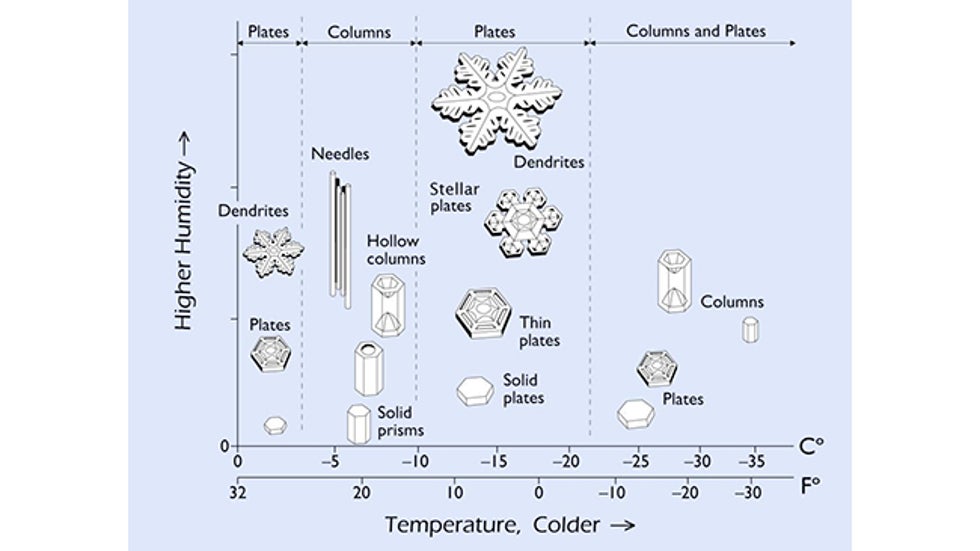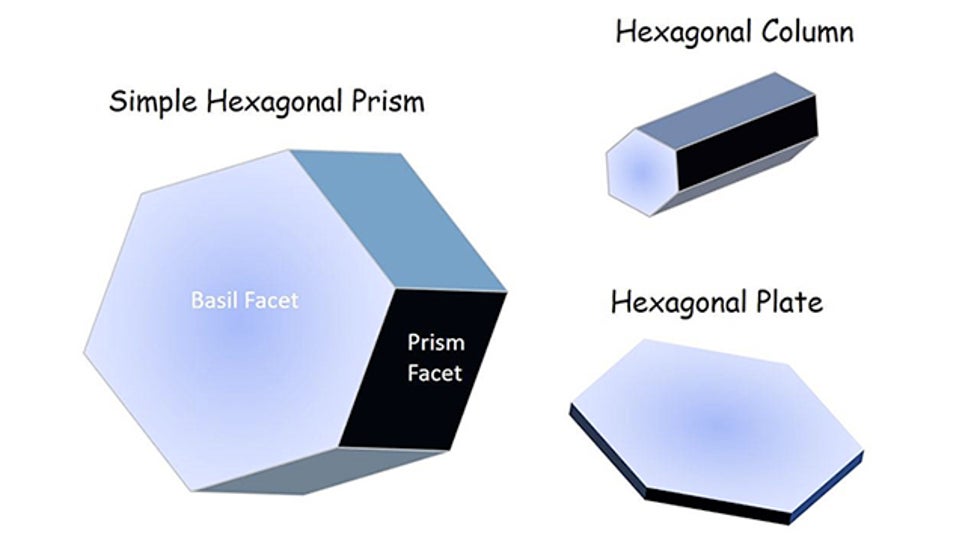Tom Niziol
I would have to guess that almost everyone who has ever seen it snow has at one time or another marveled at snowflakes.
These frozen hydrometeors seem otherworldly in their appearance, color, the way they feel when they touch the skin and even the way they taste when they land on the tongue.
A fresh blanket of billions of these flakes can turn a mountainside into a winter recreation mecca. A slight coating on a frozen roadway can turn the thoroughfare into a dangerous, slippery surface for travel.
But if you take the time to look really close at a snowflake – or more accurately a snow crystal – what you will uncover is a whole new world of wonder.
 This is the type of snow crystal that most people are familiar with. It is referred to as a spatial dendrite with six legs growing outward from a central hexagonal base. Notice the amazing detail to this structure. This crystal was photographed with an Olympus TG-6 camera, which has a great microscope function.
This is the type of snow crystal that most people are familiar with. It is referred to as a spatial dendrite with six legs growing outward from a central hexagonal base. Notice the amazing detail to this structure. This crystal was photographed with an Olympus TG-6 camera, which has a great microscope function.You may be familiar with the traditional snowflake like the one above, that six-legged object that is often found in everything from Christmas ornaments to a piece of fine jewelry.
SPONSORED: Up to 50% off at Regatta Great Outdoors
When you see those big, fluffy snowflakes that fall from the sky, you may not know it, but they are usually composed of hundreds of those six-legged spatial dendrites that interlock together to form those big clusters.
Individual snow crystals are much smaller. Some are not much bigger than the ball on a ball-point pen.
There are also many different types of snow crystals. It wasn't until I started photographing them that I began to unlock for myself the true miracle of this atmospheric factory that produces so many varieties.
There are dendrites, plates, columns, capped-columns, prisms, needles and other even more exotic designs.
Those crazy shapes are all part of the way in which snow crystals form, a delicate dance of physics on a molecular scale, that is an extremely complicated enterprise. However, in a general sense, scientists have boiled it down to some basic rules.
The formation of a snow crystal is mainly dependent on two properties: the temperature and moisture in the clouds where they first develop and eventually fall through on their way to earth.
Ukichiro Nakaya was a scientist who developed a system for snow crystal formation in the 1930s known as the Nakaya diagram.
 The Nakaya diagram showing at what temperatures (horizontal axis) and humidity (vertical axis) certain snow crystals form.
The Nakaya diagram showing at what temperatures (horizontal axis) and humidity (vertical axis) certain snow crystals form.Snow crystals form high in the clouds then grow in different ways as they fall through myriad temperature and humidity conditions on their descent toward earth.
Nakaya beautifully described the snow crystal as "a letter from the sky" because you could "read" the meteorological information "written" on the snow crystal as it fell through all of those layers on its way to the earth.
 Snow crystals begin with a simple hexagonal prism having two basil facets, or sides, and six prism facets.
Snow crystals begin with a simple hexagonal prism having two basil facets, or sides, and six prism facets.All snow crystals start off as a hexagonal prism as shown above.
The crystal grows and, depending on its thickness, can either end up as a flat plate, from which the snow crystals you are most familiar with will form, or sometimes into a thick hexagonal column not unlike a pencil, or even stranger shapes as shown in the slideshow at the top of this article.
All snow crystals are six-sided because of a wonderful characteristic of the most plentiful liquid on earth – water.
In its solid state, the atoms of a water molecule, two hydrogens and one oxygen, combine with other water molecules to take on a hexagonal configuration.
These hexagonal columns, shown in the second and third photos in the slideshow at the top of this article, were photographed on a very cold day through a microscope. The colors in my photos are due to the way in which I backlit them with different LED flashlights to highlight all of those beautiful facets, like you would see in an expensive gemstone.
I mentioned that all snow crystals begin with a six-sided hexagonal base, but some of them take on very odd hexagonal shapes, as the fourth and fifth slides in my slideshow of crystals atop the article show.
When temperatures in the clouds are cold but getting closer to the freezing point, the crystals will exist in an environment with tiny supercooled water droplets that will freeze as they contact the dendrites.
This is known as riming, and when a lot of riming takes place, the hexagonal crystal may bear very little resemblance to its original shape, as shown in the second photo below taken on Jan. 8, 2021.
I have other examples of these heavily rimed snow crystals in the eighth and ninth slides in the slideshow atop the article.
For those who would like to explore the science behind snow crystals and see some of the best photography the world has to offer, the website snowcrystals.com is the definitive guide.
I have always found that one of the best ways to get through the winter season is to get outside and enjoy what nature has to offer.
The next time those snow flurries are in the forecast, get bundled up, head outside and get ready to do a little detective work.
If you are patient and look very closely at those snow crystals, you may find some real wonders of nature. Best of luck and stay warm!
The Weather Company’s primary journalistic mission is to report on breaking weather news, the environment and the importance of science to our lives. This story does not necessarily represent the position of our parent company, IBM.
The Weather Company’s primary journalistic mission is to report on breaking weather news, the environment and the importance of science to our lives. This story does not necessarily represent the position of our parent company, IBM.

No comments:
Post a Comment